
An aircraft is a vehicle that is able to fly by gaining support from the air. It counters the force of gravity by using either static lift or the dynamic lift of an airfoil, or, in a few cases, direct downward thrust from its engines. Common examples of aircraft include airplanes, helicopters, airships, gliders, paramotors, and hot air balloons.

An airship or dirigible balloon is a type of aerostat or lighter-than-air aircraft that can navigate through the air under its own power. Aerostats gain their lift from a lifting gas that is less dense than the surrounding air.
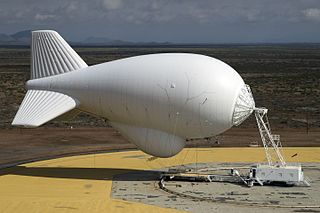
An aerostat is a lighter-than-air aircraft that gains its lift through the use of a buoyant gas. Aerostats include unpowered balloons and powered airships. A balloon may be free-flying or tethered. The average density of the craft is lower than the density of atmospheric air, because its main component is one or more gasbags, a lightweight skin containing a lifting gas to provide buoyancy, to which other components such as a gondola containing equipment or people are attached. Especially with airships, the gasbags are often protected by an outer envelope.
JP Aerospace is an American company that aims to achieve affordable access to space. Their main activities include high-atmospheric lighter-than-air flights carrying cameras or miniature experiments called PongSats and minicubes. They are also engaged in an Airship to Orbit project.
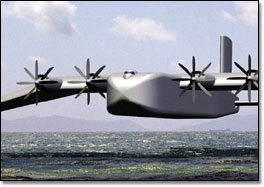
The Boeing Pelican ULTRA was a proposed ground effect fixed-wing aircraft under study by Boeing Phantom Works in the early 2000s.

Cargolifter AG was a German company founded in 1996 to offer logistical services through point-to point transport of heavy and outsized loads. This service was based on the development of a heavy lift airship, the CL160, a 550,000 m3 (19,000,000 cu ft) vessel designed to carry a 160 t payload. The airship was never built and the company went bankrupt in July 2002. Today, shareholder-founded CL CargoLifter GmbH & Co. KG company seeks to continue selling the lighter-than-air technology. CargoLifter and Russia’s Aerosmena are among those developing huge airships that can lift up to 600 tons of freight while hovering above the ground or sea.

A hybrid airship is a powered aircraft that obtains some of its lift as a lighter-than-air (LTA) airship and some from aerodynamic lift as a heavier-than-air aerodyne.

The Lockheed Martin P-791 is an experimental aerostatic and aerodynamic hybrid airship developed by Lockheed Martin. The first flight of the P-791 took place on 31 January 2006 at the company's flight test facility at United States Air Force Plant 42 in Palmdale, CA.

A semi-rigid airship is an airship which has a stiff keel or truss supporting the main envelope along its length. The keel may be partially flexible or articulated and may be located inside or outside the main envelope. The outer shape of the airship is maintained by gas pressure, as with the non-rigid "blimp". Semi-rigid dirigibles were built in significant quantity from the late 19th century but in the late 1930s they fell out of favour along with rigid airships. No more were constructed until the semi-rigid design was revived by the Zeppelin NT in 1997.

Metal-clad airships are airships which have a very thin airtight metal envelope, rather than the usual fabric envelope. This shell may be either internally braced as with the designs of David Schwarz, or monocoque as in the ZMC-2. Only four ships of this type are known to have been built, and only two actually flew: Schwarz's aluminum ship of 1893 collapsed on inflation; Schwarz's second airship flew at Tempelhof, Berlin in 1897, landed but then collapsed; the ZMC-2 flew 752 flights between 1929 and scrapping in 1941; while the Slate City of Glendale, was built in 1929 but never flew.
Aeros Corp is an American manufacturer of airships based in Los Angeles, California. It was founded in 1993 by the current CEO and Chief Engineer, Igor Pasternak, who was born in Soviet Kazakhstan, raised in Soviet Ukraine, and moved to the U.S. after the Soviet collapse to build airships there. It currently employs more than 100 workers.

Non-rocket spacelaunch refers to theoretical concepts for launch into space where much of the speed and altitude needed to achieve orbit is provided by a propulsion technique that is not subject to the limits of the rocket equation. Although all space launches to date have been rockets, a number of alternatives to rockets have been proposed. In some systems, such as a combination launch system, skyhook, rocket sled launch, rockoon, or air launch, a portion of the total delta-v may be provided, either directly or indirectly, by using rocket propulsion.
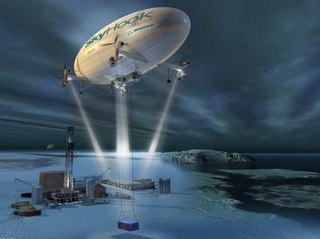
The SkyHook JHL-40 was a proposed hybrid airship/helicopter. On July 9, 2008, Boeing announced that it had teamed up with SkyHook International, a Canadian company, to develop this aircraft. No further press releases appear after 2009 and Skyhook International has abandoned its domain name registration since 2010 as shown by the Internet Archive.
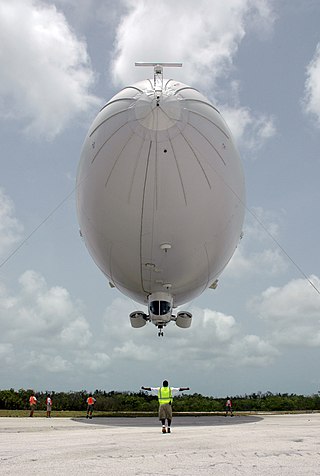
Airship Industries was a British manufacturers of modern non-rigid airships (blimps) active under that name from 1980 to 1990 and controlled for part of that time by Alan Bond. The first company, Aerospace Developments, was founded in 1970, and a successor, Hybrid Air Vehicles, remains active as of 2022. Airship Industries itself was active between 1980 and 1990.
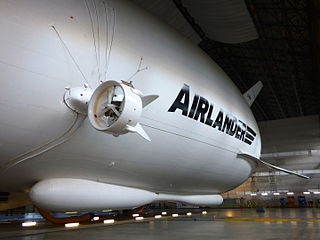
The Hybrid Air Vehicles Airlander 10 is a hybrid airship designed and built by British manufacturer Hybrid Air Vehicles (HAV). Comprising a helium airship with auxiliary wing and tail surfaces, it flies using both aerostatic and aerodynamic lift and is powered by four diesel engine-driven ducted propellers.

The AeroLift CycloCrane was a unique US hybrid airship which adopted helicopter derived airfoil control for low speed flight manoeuvring by spinning on its axis. It was intended to be a heavy load lifter, initially aimed at the Canadian logging industry. A proof of concept vehicle flew at times during the 1980s, but no large production aircraft were built.

Hybrid Air Vehicles (HAV) Limited is a British limited company and a British manufacturer of hybrid airships, though none have been built since the crash of its last demonstrator in Nov 2017. These aircraft use both aerodynamics and lighter-than-air (LTA) technology to generate lift, potentially allowing the vehicle to stay aloft for several weeks.
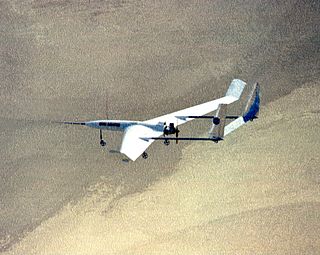
A Mars aircraft is a vehicle capable of sustaining powered flight in the atmosphere of Mars. So far, the Mars helicopter Ingenuity is the only aircraft ever to fly on Mars, completing 72 successful flights covering 17.242 km (10.714 mi) in 2 hours, 8 minutes and 48 seconds of flight time. Ingenuity operated on Mars for 1042 sols, until its rotor blades, possibly all four, were damaged, causing NASA to retire the craft.
Kuang-Chi Group is a Chinese company that develops and invests in metamaterial, telecommunication, aerospace, smart-city, AI and digital health technologies.
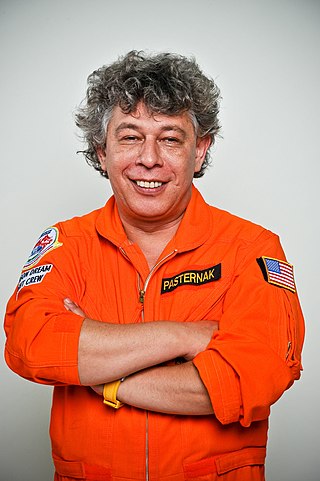
Igor Pasternak is an American aviation entrepreneur, inventor and engineer specializing in designing and building airships. He is best known as the founder and CEO of Worldwide Aeros Corp, an American manufacturer of airships based in Montebello, California and for his research on variable buoyancy control for airships. Igor Pasternak is an advocate of the cargo airship industry and lighter-than-air flight.
















